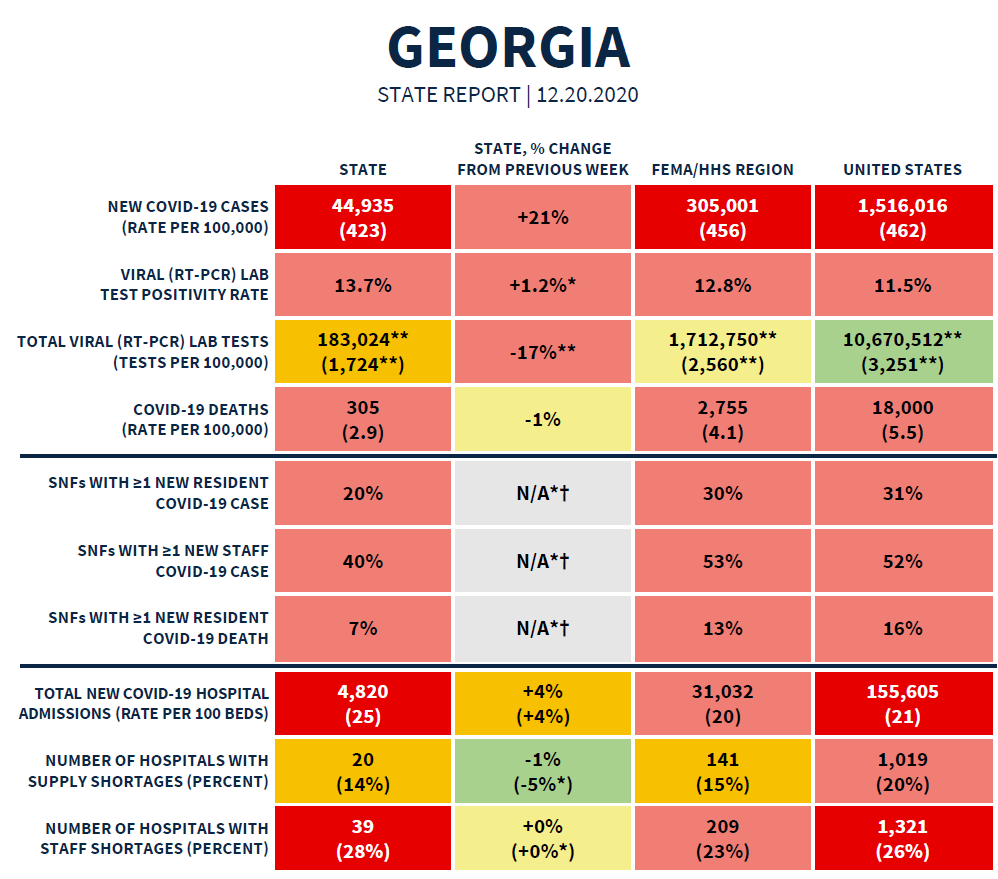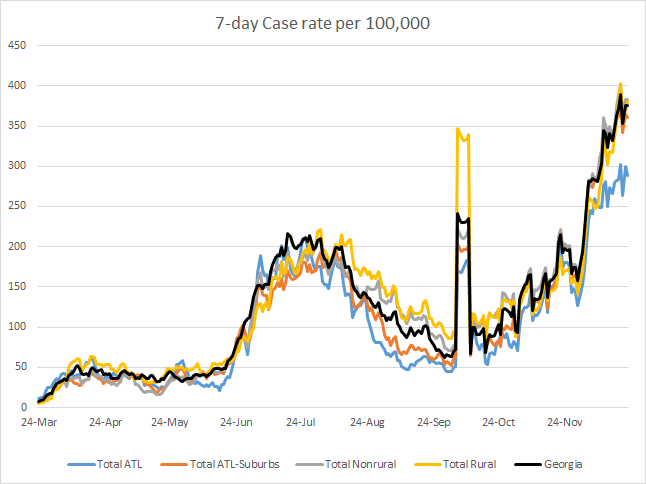With it being a holiday week and the kids out of school, I’m going to resume our vaccine series next week, looking at safety data next.
Just as we saw for Thanksgiving, we should anticipate some reporting delays this week with testing centers and labs closing for the holiday. Because next week is also a holiday week, we should anticipate that data reporting is going to be really strange for the next two weeks. By the end of the first full week of January, we should start to see things get back to normal.
With the Christmas and Kwanzaa holidays I want to go over the continuum of risk as you are planning your gatherings. If you are over the age of 65 or have an underlying medical condition then I strongly encourage you to stick to the “safest option” below. People in this category should avoid ANY indoor encounter with people outside of their household.
Safest option: limit your gatherings to just the people with whom you live. Celebrate with non-household friends and family via Zoom or other virtual technology.
Safer option: small (maybe 2-3 households) gathering outdoors, with masks, and seated in household groups. Keep indoor time as brief (i.e. to use the restroom) as brief as possible and wear a mask the entire time.
Moderate risk: small (i.e. 2 households) gathering indoors with doors and windows open to allow for better ventilation. The goal is to avoid re-breathing the air that someone else just exhaled. Wear masks the entire time. Keep the duration of the gathering a short as possible.
Very risky: celebrating in a manner similar to how you celebrated in years past - large gatherings, indoors with windows and doors closed, for several hours.
If you gather with anyone in the Moderate or Very Risky end of the risk continuum, then you should assume you were infected and act accordingly because you are a hazard to other people. Avoid contact with anyone over the age of 65 or who has an underlying medical condition. Self-quarantine for 10-14 days and schedule an appointment now to be tested for COVID-19 next week. The ideal time is 4-7 days after a high risk exposure, so Tuesday - Thursday of next week since most testing centers will likely be closed on New Years Day. Of course, just as for Thanksgiving, we expect Christmas to be a high-transmission day but it won’t be limited to that day. It will lead to ripple effects and secondary transmissions in the weeks to come. The same people who ignore public health guidance and gather with their family and friends this week will likely also ignore the guidance to self-quarantine after their gatherings. They will be at restaurants, bars, New Years parties and stores next week during their infectious period. If you are in a high risk category, next week would be a good time to shelter in place and order your groceries and medications.
Some good news, with the daily release of the Community Profile Reports, the White House Coronavirus Task Force (WHCTF) report now includes Georgia’s antigen cases. You can tell by the number of cases they reported for the past week and also graphs like the one below that show a large data dump of ~30,000 antigen cases that CDC added to Georgia’s total, all at once. So finally, the rankings for Georgia are a fair ranking compared to other states. It does sort of beg the question, at what point will Georgia DPH update its maps and graphs to give its public an honest account of how the pandemic is unfolding by including both PCR and antigen cases as every other government agency does? I mean, the CDC and the WHCTF are no longer playing along with how Georgia chooses to report case data.
You can read the 20Dec2020 WHCTF report for Georgia in full here. Georgia’s rankings this week are #26 for new cases per 100,000, #18 for PCR test positivity, #12 for new COVID-19 hospital admissions per 100 beds (just outside of the top color category), and #44 for new deaths per 100,000. However, as the WHCTF notes in their summary, Georgia should expect that deaths will rise soon.
The language this week is very direct, saying that more must be done to “ensure as many Americans as possible can survive to be immunized.”
Here’s the summary table for Georgia. We are in the red zone for most metrics. What is especially concerning is how many skilled nursing facilities (SNFs) have at least one new COVID-19 case among their staff - it is 40%. That is one of the primary ways that disease gets into a nursing home, through the people who live outside of that bubble. This week 14% of Georgia hospitals report supply shortages and 28% report staff shortages.
Testing
The Georgia PCR positivity rate is back to being higher than the national average since early December, after about 6 weeks of being below the national average. We are ranked #18 in the nation for this metric. Both the state and the nation are well above the goal of 5% positivity. What this means is that we are likely missing cases because we aren’t testing widely enough. Those missed cases go on to contribute to ongoing disease transmission in their communities.
And sure enough, Georgia is well below the national average for test output by PCR. We have never been equal to the national average but the gap has widened over time. As of this week, Georgia is performing COVID-19 PCR testing at a rate that is 47% less than the national test rate. To be fair, the data provided by the WHCTF do not consider antigen testing in this calculation. It is possible that Georgia is doing better than this if antigen test output were included. But Georgia DPH doesn’t provide those numbers to the public, and presumably doesn’t to the CDC or the WHCTF.
Today, Georgia DPH reported 36,781 new PCR test results, an average output. Of those tests, 15.2% were positive. Georgia DPH does not provide numbers of tests performed by antigen test nor its percent positive. However, we do know that antigen cases identified 33.7% of today’s net increase in cases. So they’re diagnosing one in every three cases.
Cases
The WHCTF report actually started including the antigen cases in last week’s report, dated 13Dec2020. So the last two weeks of increase are real, that really is our most accurate case rate, but the trajectory of our increase over time would probably be more parallel to the national case rate than the sharp increase we saw between the 06Dec and 13Dec reports.
We have a LOT of counties (132) in the red zone.
And here is where those red counties are located.
Yesterday Georgia surpassed 600,000 COVID-19 infections between PCR and antigen test-identified cases. In fact, yesterday we set a new record for the most cases reported in a single day - 9079. Today, there was a net increase of 5153 PCR-identified cases and 2620 antigen-identified cases for a combined total of 7773 compared to yesterday’s combined total. Of today’s newly reported cases, 35% came from nonrural counties outside of the Atlanta metro, 27% came from rural counties, 24% came from Atlanta suburb counties and 10% came from the Atlanta counties of Fulton and DeKalb. Atlanta seems to be flattening this curve more so than the rest of the state, if you look at the 7-day case rate per 100,000 in the graph shown below. Ignore the weird spike around early October - that’s a data dump of 26,000 antigen cases all at once.
Hospitalizations
The number of COVID-19 patients hospitalized in Georgia continues to trend up. A reminder, while many people like to say that this is a disease that primarily affects the elderly, I’d point to the graph below that shows that the biggest demand on our hospitals is actually middle aged adults between 40-69. And the number of patients between 18-39 has been growing since Thanksgiving.
Our new hospital admissions per 100 beds for COVID-19 is above the national average. In fact, we are ranked #12 for this.
Here’s where hospital demand is greatest.
As of today’s updates from Georgia DPH and the GIO data hub, there are 3756 Georgians currently hospitalized for COVID-19. This is a new record just as 6 of the past 7 days have been. The increases we are noting here show no sign of flattening. Meanwhile, 88% of the state’s ICU beds are full, even before we feel the impacts of Christmas. There were 303 new hospital admission for COVID-19 today and 45 admissions to the ICU.
Deaths
The death rate per 100,000 is flat for Georgia in the most recent WHCTF report while the national rate continues to increase. As the WHCTF noted, however, in their summary statement, we should expect that COVID-19 fatalities in Georgia will rise soon.
Today there were 51 newly reported confirmed COVID-19 deaths. Whereas the statewide case fatality rate has been dropping like a stone since the case surge began and now sits at 1.6%, the case fatality rate for rural counties is 2.3%.
Vaccine Distribution
This week we should expect that there will be a slow down in vaccine distribution due to the holiday. In addition, there is a ~24 hour delay in reporting to the Vaccine Status Dashboard. So we’re really looking at data that are probably 2 business days old at any given time. As of yesterday’s update the state of Georgia has 156,775 doses of the Pfizer and Moderna vaccines on hand, and has administered just 11.4% of those doses. In other words, 0.17% of the Georgia population is vaccinated against the virus. We need to get to 70% or more. So it’s going to be a while before we get there.
In the meantime, the non-pharmaceutical interventions such as mask wearing, social distancing and good hand hygiene are going to continue to be the most effective ways we have to limit disease transmission. So hang in there and stay the course.
I’m going to take Friday (Christmas Day) off from the newsletter. So please don’t worry, all is well. I know that this year has been awful for a number of reasons. But it has also given me the chance to gain perspective on the things that matter most to me and to separate meaning and purpose from the noise of day to day life. I know this time of year can be very lonely and will be even more so this year with our limited ability to gather. But please know that we are all doing this out of love and concern for our friends, families, neighbors and communities. I look forward to the holidays in the future that will look and feel far more normal. We will get there.
References
https://beta.documentcloud.org/documents/20432981-georgia_12_13_2020
https://beta.documentcloud.org/documents/20436869-georgia-12_20_20
https://dph.georgia.gov/covid-vaccine
https://dph.georgia.gov/covid-19-daily-status-report
Georgia COVID-19 Updates is a free newsletter that depends on reader support. If you wish to subscribe please click the link below. There are free and paid options available.
My Ph.D. is in Medical Microbiology and Immunology. I've worked at places like Creighton University, the Centers for Disease Control & Prevention and Mercer University School of Medicine. All thoughts are my professional opinion and should not be considered medical advice.

















